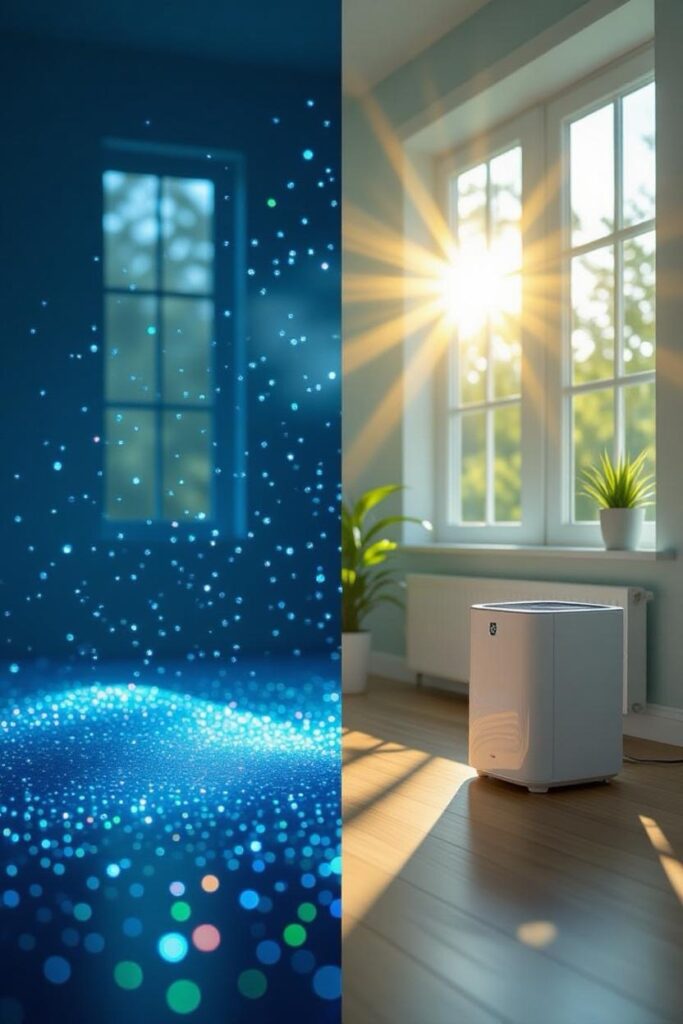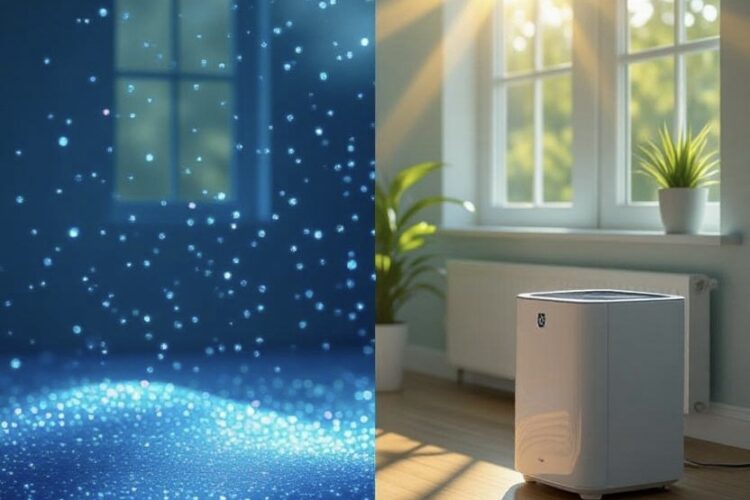Invisible threats like airborne microplastics, indoor pollutants, and environmental degradation harm our health, with studies showing we inhale up to 68,000 microplastic particles daily. These tiny synthetic fibers, along with dust, VOCs, and PM2.5 from wildfires, infiltrate homes, causing respiratory issues, heart disease, and even cancer. Air purifiers with HEPA filters capture 99% of particles as small as 0.3 microns, slashing health risks by removing microplastics, fine dust, and toxins. Regular filter replacement and good ventilation enhance their effectiveness. In a polluted world, air purifiers are essential for protecting long-term health and survival.
Long Version
The Essential Role of Air Purifiers in Safeguarding Against Invisible Threats
In an era where environmental pollution permeates every aspect of daily life, the air we breathe indoors—once considered a safe haven—has become a battleground for unseen adversaries. Airborne microplastics, indoor pollutants, and broader environmental degradation pose escalating risks to respiratory health and overall well-being. As of October 2025, studies reveal that humans inhale up to 68,000 microplastic particles daily, exacerbating health risks from chronic exposure. These threats aren’t mere inconveniences; they represent a critical challenge to long-term health and survival. Air purifiers, equipped with advanced filtration technologies, emerge not just as comfort enhancers but as indispensable tools in mitigating these dangers. This article delves deeply into the nature of these invisible threats, their impacts, and why integrating air purification systems into homes is essential.
Unseen Dangers Lurking in the Air
The modern home harbors a cocktail of airborne particles that originate from both internal sources and external environmental behaviors. Airborne microplastics—tiny synthetic polymers derived from plastic degradation—float through atmospheric currents, infiltrating indoor spaces via ventilation systems and open windows. These microplastic particles, often measuring less than a micron in size, stem from synthetic fibers in clothing, carpets, and upholstery, releasing into the air through everyday activities like walking or cleaning.
Indoor contaminants compound this issue. Common sources include dust, fine dust from household products, pet dander, mold, and persistent organic pollutants from building materials and furnishings. Volatile organic compounds (VOCs) from paints, cleaners, and tobacco smoke add to the mix, while radon and asbestos from aging conditions in older structures pose silent risks. Even biological agents like biofilm on damp surfaces contribute to poor indoor air quality, fostering an environment ripe for pollution buildup.
Environmental degradation amplifies these problems on a macro scale. Climate change drives worsening air pollution through increased wildfires, which release PM2.5 and PM10 particles that seep indoors. Deforestation and industrial activities accelerate degradation, leading to higher levels of environmental pollution that infiltrate homes via air turbulence and atmospheric currents. This interplay creates a vicious cycle where outdoor pollutants exacerbate indoor ones, turning homes into reservoirs of adsorbed pollutants and heavy metals bound to particles.
Health Risks and Long-Term Implications
Exposure to these threats exacts a heavy toll on the human respiratory system. Airborne microplastics, once inhaled, can lodge in the lungs, causing inflammation and oxidative stress that heighten risks of respiratory diseases, asthma aggravation, and even lung cancer. Their toxicity stems not only from the particles themselves but from adsorbed pollutants like heavy metals and persistent organic pollutants, which may trigger systemic effects including heart attacks, strokes, and infertility. Studies from 2025 highlight that microplastics in carotid arteries double the likelihood of cardiovascular events, underscoring their role in chronic conditions.
Indoor pollutants similarly endanger health, with short-term effects like headaches and nausea from VOCs, and long-term consequences such as ischemic heart disease, chronic obstructive pulmonary disease, and cognitive deficits. Biological contaminants trigger allergies and infections, while chemical ones like formaldehyde from furnishings contribute to cancer risks. Environmental degradation’s impact manifests in broader ecosystem harm—acid rain and ozone depletion—that indirectly affects human health by degrading air quality, leading to 4.2 million premature deaths annually from ambient pollution.
Collectively, these factors pose existential threats to survival, particularly for vulnerable groups like children and the elderly. Prolonged exposure disrupts immune responses, promotes antimicrobial resistance, and accelerates aging conditions, making proactive defense imperative.
How Air Purifiers Serve as a Critical Defense
Air purifiers stand as a frontline safeguard, transforming indoor air quality by capturing airborne particles before they reach the lungs. High-efficiency particulate air (HEPA) filters, the cornerstone of most air purification systems, trap 99% of particles as small as 0.3 microns, effectively removing PM2.5, PM10, dust, and microplastic particles. Recent tests show HEPA-equipped purifiers can eliminate up to 98.73% of microplastic-sized particles within an hour, significantly reducing inhalation risks.
Beyond particulates, these systems address indoor contaminants through multi-stage filtration, including activated carbon for adsorption of VOCs and heavy metals. In homes affected by environmental pollution, purifiers mitigate influx from outdoor sources, maintaining cleaner air amid wildfires or urban smog. For long-term health, they alleviate respiratory health burdens, reducing asthma symptoms and allergen exposure, while potentially lowering cancer and cardiovascular risks tied to chronic pollution.
The Science Behind Air Purification Systems
HEPA filtration operates via mechanical processes: interception for larger particles, impact for mid-sized ones, and diffusion for ultrafine contaminants under 0.1 microns. This dense fiber matrix captures synthetic fibers, fine dust, and even biofilm fragments without relying on chemicals. Air turbulence within the unit enhances efficiency, ensuring thorough processing.
Advanced models incorporate UV lights or ionizers to neutralize persistent organic pollutants and microbes, while clean air delivery rates (CADR) measure their prowess against specific threats like PM2.5. Research confirms that running HEPA purifiers for 48 hours can slash indoor PM2.5 by 40-50%, directly countering plastic degradation products and environmental behaviors that introduce pollutants. However, purifiers themselves must be monitored to avoid becoming sources of microplastics if filters degrade improperly.
Practical Considerations: Choosing and Maintaining Your Air Purifier
Selecting the right system hinges on room size, specific threats, and filter type. Opt for true HEPA filters over lesser variants for optimal capture of micron-sized particles. Features like smart sensors for real-time air quality monitoring add value, especially in polluted urban areas.
Maintenance is key: Replace filters every 6-12 months to prevent re-release of captured pollutants. Combine with good ventilation to avoid over-reliance, ensuring a holistic approach to combating exposure. Costs vary, but the investment pays dividends in health savings, with studies linking cleaner air to fewer medical visits.
Toward Healthier Horizons
In the face of escalating airborne microplastics, indoor pollutants, and environmental degradation, air purifiers transcend luxury status to become vital for survival. By bolstering indoor air quality and shielding the human respiratory system from toxicity, they offer a proactive shield in an increasingly contaminated world. Integrating these systems isn’t optional—it’s a strategic imperative for enduring health amid pervasive pollution.

Breathing clean shouldn’t be a gamble—air purifiers help tip the odds in our favor.
Hashtags For Social Media
#AirPurifier #CleanAir #IndoorAirQuality #Microplastics #AirPollution #HEPAFilter #BreatheEasy #PollutionFree #EnvironmentalHealth #SustainableLiving #EcoFriendly #HealthAndWellness #GreenHome #ToxinFree #RespiratoryHealth #FightPollution #AirQuality #PlasticPollution #InvisibleThreats #HomeHealth #PurifyAir #AllergyRelief #ClimateAction #EnvironmentalProtection #WellnessJourney #HealthyLiving #Sustainability #EcoWarrior #BreatheBetter #AirPurification
Related Questions, Words, Phrases
do air purifiers protect against microplastics | is an air purifier essential for indoor pollutants | best air purifiers for airborne microplastics removal | how air purifiers shield from environmental toxins | air purifiers vs indoor air pollution threats | do hepa filters block microplastics effectively | essential air purifiers for health against pollutants | air purifier benefits for microplastic exposure | top shields: air purifiers against airborne dangers | why use air purifiers for microplastics and dust | air purifiers as defense from invisible pollutants | must-have air purifiers for toxin-free home | how to combat microplastics with air purifiers | air purifiers essential for pollution protection | shielding your lungs: air purifiers vs pollutants | best devices to filter microplastics from air | air purifiers for safeguarding against degradation | essential role of air purifiers in pollutant defense | top air purifiers to battle airborne microplastics | do air purifiers really stop indoor toxins | air purifier guide for microplastic and pollutant removal | why air purifiers are vital shields against pollution | hepa air purifiers for microplastics and fine dust | air purifiers: key defense vs environmental threats | how effective are air purifiers against pollutants | essential air purification for microplastic threats | air purifiers to protect from airborne hazards | best ways air purifiers shield from toxins | air purifiers as essential barriers to pollutants | combating indoor microplastics with air purifiers | why invest in air purifiers for pollution defense | air purifiers for ultimate shield against microplastics | do air purifiers help with environmental pollutants | top air purifier options for toxin shielding | air purifiers essential for clean air vs pollutants






